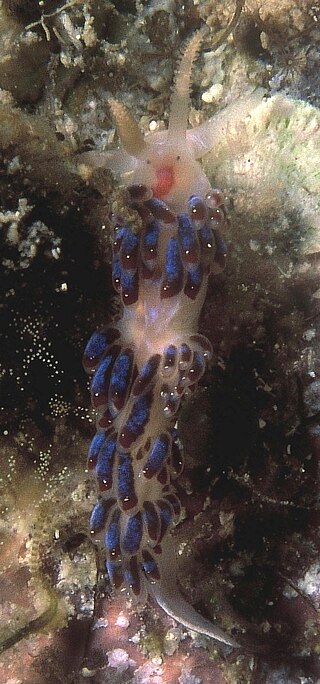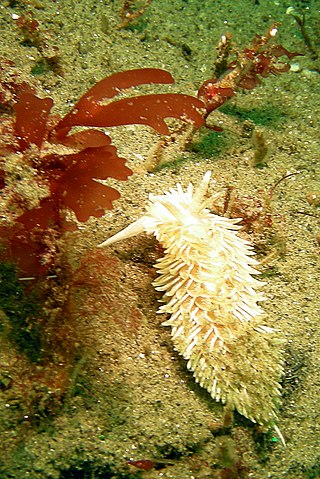
Eubranchidae is a taxonomic family of sea slugs, marine gastropod molluscs in the superfamily Aeolidioidea, the aeolid nudibranchs.

The candelabra nudibranch, is a species of sea slug or nudibranch, a marine gastropod mollusc in the family Eubranchidae. It is an aeolid nudibranch, which is known to occur off the South African coast. As of August 2015, it remained undescribed by science.

Eubranchus is a genus of aeolid nudibranch in the family Eubranchidae.

Eubranchus exiguus is a species of small sea slug, an aeolid nudibranch, a marine gastropod mollusc in the family Eubranchidae.

Facelina is a genus of sea slug, an aeolid nudibranch in the family Facelinidae.

Ziminella salmonacea, common name the salmon aeolis, is a species of sea slug, an aeolid nudibranch, a marine gastropod mollusc in the family Paracoryphellidae.
Flabellina dushia is a species of sea slug, an aeolid nudibranch, a marine gastropod mollusc in the family Flabellinidae.

Flabellina engeli is a species of sea slug, an aeolid nudibranch, a marine gastropod mollusc in the family Flabellinidae.

Borealea nobilis is a species of sea slug, an aeolid nudibranch, a marine heterobranch mollusc in the family Flabellinidae.

Carronella pellucida is a species of sea slug, an aeolid nudibranch, a marine heterobranch mollusc in the family Flabellinidae. It is occasionally referred to as the milky white sea slug, the pellucid aeolid, or the red-gilled nudibranch, though these names are not commonly accepted in formal settings.
Piseinotecus gonja is a species of sea slug, an aeolid nudibranch, a marine gastropod mollusk in the family Piseinotecidae.
Piseinotecus kima is a species of sea slug, an aeolid nudibranch, a marine gastropod mollusk in the family Piseinotecidae.

Tenellia phoenix is a species of sea slug, an aeolid nudibranch, a marine gastropod mollusc in the family Fionidae.
Berghia dakariensis is a species of sea slug, an aeolid nudibranch. It is a shell-less marine gastropod mollusc in the family Aeolidiidae.
Facelina dubia is a species of sea slug, an aeolid nudibranch, a marine gastropod mollusc in the family Facelinidae.
Cerberilla tanna is a species of sea slug, an aeolid nudibranch, a marine heterobranch mollusc in the family Aeolidiidae.

Eubranchus conicla is a species of sea slug or nudibranch, a marine gastropod mollusc in the family Eubranchidae.

Baeolidia ransoni is a species of sea slug, an aeolid nudibranch. It is a marine gastropod mollusc in the family Aeolidiidae.

Amphorina is a genus of aeolid nudibranch in the family Eubranchidae.











